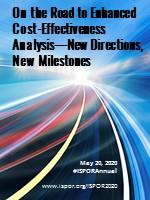Capturing Patient and Societal Values in Value Assessment Frameworks
 Lawrenceville, NJ, USA—May 20, 2020—ISPOR—The Professional Society for Health Economics and Outcomes Research (HEOR) held its third and final Virtual ISPOR 2020 plenary session this afternoon, “On the Road to Enhanced Cost-Effectiveness Analysis—New Directions, New Milestones.” Virtual ISPOR 2020 is the Society’s first completely virtual conference that was redesigned as an online event when the COVID-19 pandemic required a necessary cancellation of the in-person conference.
Lawrenceville, NJ, USA—May 20, 2020—ISPOR—The Professional Society for Health Economics and Outcomes Research (HEOR) held its third and final Virtual ISPOR 2020 plenary session this afternoon, “On the Road to Enhanced Cost-Effectiveness Analysis—New Directions, New Milestones.” Virtual ISPOR 2020 is the Society’s first completely virtual conference that was redesigned as an online event when the COVID-19 pandemic required a necessary cancellation of the in-person conference.
This plenary session explored a number of innovative approaches that can help capture patient and societal values in value assessment frameworks that go beyond the standard cost per quality-adjusted life year (QALY) usage. The expert panel discussed the underlying methods of these approaches and their potential for use in healthcare decision making. Speakers included:
- Moderator: Deborah Freund, MA, MPH, PhD; Claremont Graduate University; Claremont, CA, USA
- Anirban Basu, PhD; University of Washington; Seattle, WA, USA
- Susan Griffin, PhD; University of York; York, England, UK
- Darius Lakdawalla, PhD; University of Southern California; Los Angeles, CA, USA
Darius Lakdawalla, PhD began the session with his remarks on cost-effectiveness analysis (CEA) and value assessment frameworks. He pointed out that CEA often struggles to match the value that patients place on particular therapies, especially patients with severe and/or rare diseases. In fact, policy makers often disregard cost-effectiveness criteria when treating severe illnesses for this reason. He described how ISPOR has worked to tackle this problem in a number of ways. The ISPOR US Value Assessment Frameworks Initiative addressed this with the Special Task Force publishing 7 ISPOR Reports. One of these reports, “Defining Elements of Value in Health Care—A Health Economics Approach: An ISPOR Special Task Force Report,” comprised a “value flower” that outlined various value aspects that included additional value elements that have been proposed. Dr Lakdawalla has been focused on developing microeconomic foundations for a broader set of value aspects focusing on 4 that are risk-based values—(1) insurance value, (2) severity of disease, (3) value of hope, and (4) reduction in uncertainty—that can help address the value that patients with severe and rare diseases place on health technologies.
Susan Griffin, PhD spoke next about work she has been doing at the University of York on equity, disparity, and inequality—distributional cost-effectiveness analysis (DCEA). This work focuses on a principle that “everyone deserves an equal chance for good health regardless of their socioeconomic characteristics.” While this principle has much support, this is not the case in reality. What we actually observe are systematic and persistent differences in quality of life and life expectancy that are associated with socioeconomic differences (eg, where you are born, race, gender, ethnicity). Dr Griffin stressed that healthcare is both a determinant of health and a lever by which inequality can be addressed. This provides the opportunity for healthcare to offer the dual objectives of improving health and reducing inequality. The methodology of DCEA can offer quantitative information on how different choices affect health inequality.
Anirban Basu, PhD spoke next outlining his work on a new effectiveness measure for CEA, health years in total (HYT). A paper on this work was recently published in the January 2020 issue of Value in Health, “Health Years in Total: A New Health Objective Function for Cost-Effectiveness Analysis.” He described how quality-adjusted life years (QALYs) have been the primary effectiveness measure for CEA. While many health technology assessment (HTA) bodies regularly use QALYs, controversies exist around their use. For example, extending the life of a person with lower health is valued less than that of a person with better health. This has been the QALY’s Achilles heel, especially in the United States. A number of alternatives to QALYs exist (eg, life years, disability-adjusted life years [DALYs], and equal value of life [EVL], however each of these options have issues as well. In summary, HYT is a novel framework for valuing health outcomes in CEA that addresses fundamental limitations of QALYs and EVLs, is robust from a theoretical perspective, provides calculations that are feasible in CEA models, and may have important policy implications.
Deborah Freund, MA, MPH, PhD moderated a question and answer session that integrated live audience questions for the panelists. Panelists discussed how HTA bodies might be able to evaluate a new CEA metric, the challenges in adopting a societal perspective, and how DCEA might be applied to explore racial disparities in the COVID-19 pandemic.
Virtual ISPOR 2020 is being held May 18-20. Registrants will have access to the nearly 60 hours of on-demand recordings of all conference sessions through June 30. In addition to the plenary sessions, Virtual ISPOR 2020 features issue panels, workshops, podium presentations, and educational symposia. Research abstracts from the conference will continue to be published in the Society’s journal, Value in Health, and will be available in the ISPOR Presentations Database. The ISPOR Short Course Program is also be presented virtually with a variety of course topics and dates offered in June and July.
Additional information can be found at:
Virtual ISPOR 2020 | Program | Registration Information | Short Courses | COVID-19 Plenary| Press
###
ABOUT ISPOR
ISPOR, the professional society for health economics and outcomes research (HEOR), is an international, multistakeholder, nonprofit dedicated to advancing HEOR excellence to improve decision making for health globally. The Society is the leading source for scientific conferences, peer-reviewed and MEDLINE®-indexed publications, good practices guidance, education, collaboration, and tools/resources in the field.
Website | LinkedIn | Twitter (@ispororg) | YouTube | Facebook